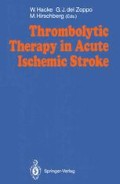Abstract
Since the time of William Harvey, physiologists, anatomists, and clinicians alike have viewed the heart and circulatory system as supporting actors whose role it was to provide blood to the various organs of the body. Arguably the principal organ supplied is the brain, which controls the perceptions, thoughts, and actions of the body. Clearly, the raison d’etre of the arteries coursing to the brain is to supply blood which carries fuel, mainly sugar and oxygen, to nervous system structures which cannot function without it. When an artery is blocked, even temporarily, the brain is deprived of fuel and stops working just as a car would without gas. If fuel is lacking for long enough, the brain wilts, softens, and dies. Some components seem more vulnerable to the lack of fuel supply and die before others.
Access this chapter
Tax calculation will be finalised at checkout
Purchases are for personal use only
Preview
Unable to display preview. Download preview PDF.
References
Babbs C (1988) Reperfusion injury of postischemic tissues. Ann Emerg Med 17:1148— 1157
Branston NM, Symon L, Crockard HA, Pasztar E (1974) Relationship between the cortical evoked potential and local cortical blood flow following acute middle cerebral artery occlusion in the baboon. Exp Neurol 45:195–208
Collins RC, Dobkin B, Choi DW (1989) Selective vulnerability of the brain: new insights into the pathophysiology of stroke. Ann Int Med 110:992–1000
Crowell RM, Olsson Y, Klatzo I, Ommaya A (1970) Temporary occlusion of the middle cerebral artery in the monkey: clinical and pathological observations. Stroke 1:439–448
Crowell RM, Marcoux FW, deGirolami U (1981) Variability and reversibility of focal cerebral ischemia in unanesthetized monkeys. Neurol 31:1295–1302
de Courten-Myers G, Kleinholz M, Wagner K, Myers R (1989) Fatal strokes in hyperglycemic cats. Stroke 20:1707–1715
Dooling EC, Richardson EP (1976) Delayed encephalopathy after strangling. Arch Neurol 33:196–199
Dougherty JH, Levy DE, Weksler BB (1979) Experimental cerebral ischemia produces platelet aggregates. Neurol 29:1460–1465
Fisher CM (1987) The history of cerebral embolism and hemorrhagic infarction. In: Furlan AJ (ed) The heart and stroke. Springer, Berlin Heidelberg, New York, pp 2–16
Fisher CM, Adams RD (1951) Observations on brain embolism with special reference to hemorrhagic infarction. J Neuropathol Exp Neurol 10:92–94; also published (1987) In: Furlan AJ (ed) The heart and stroke. Springer, Berlin, Heidelberg, New York, pp 17–36
Garcia J, Anderson M (1989) Physiopathology of cerebral ischemia. CRC Crit Rev Neurobiol 4:303–24
Garcia JH, Lowry SL, Briggs L, Mitchem HL, Morawetz R, Halsey JH, Conger KA (1983) Brain capillaries expand and rupture in areas of ischemia and reperfusion. In: Reivich M, Hurtig H (ed) Cerebrovascular diseases. Raven, New York, pp 169–179
Hagardine JR, Branston NM, Symon L (1980) Central conduction time in primate brain ischemia - a study in baboons. Stroke 11:637–642
Hakim A, Pokrupa R, Villaneuva J, Diksic M, Evans AC, Thompson CJ, Meyer E, Yamamoto YL, Feindel WH (1987) The effect of spontaneous reperfusion on metabolic function in early human cerebral infarcts. Ann Neurol 21:279–289
Hatashita S, Hoff JT (1986) Role of a hydrostatic pressure gradient in the formation of early ischemic brain edema. J Cereb Blood Flow Metab 6:546–552
Heiss W-D, Rosner G (1983) Functional recovery of cortical neurons as related to degree and duration of ischemia. Ann Neurol 14:294–301
Hossman K-A, Kleihues P (1973) Reversibility of ischemic brain damage. Arch Neurol 29:375–384
Irino T, Minami T, Taneda M, Hara K (1977) Brain edema and angiographic hyperemia in postrecanalized cerebral infarction. Acta Neurol Scand (Suppl) 64:134–35
Irino T, Taneda M, Minami T (1977) Angiographic manifestations in post recanalized cerebral infarction. Neurol 27:471–475
Jafar J, Crowell RM (1987) Focal ischemic thresholds. In: Wood JW (ed) Cerebral blood flow. McGraw-Hill, New York, pp 449–457
Kuroiwa T, Ting P, Martinez H, Klatzo I (1985) The biphasic opening of the blood- brain barrier to proteins following temporary MCA occlusion. Acta Neuropathol 68:122–129
Kuroiwa M, Shibutani M, Okeda R (1988) Blood-brain barrier disruption and exacerbation of ischemic brain edema after restoration of blood flow in experimental focal cerebral ischemia. Acta Neuropathol 76:62–70
Petito C (1979) Platelet thrombi in experimental cerebral infarction. Stroke 10:192- 196
Plum F (1983) What causes infarction in ischemic brain: the Robert Wartenberg Lecture. 33:222–233
Plum F, Posner JB, Hain RF (1962) Delayed neurological deterioration after anoxia. Arch Neurol 110:18–25
Plum F, Posner JB, Alvord EC (1963) Edema and necrosis in experimental cerebral infarction. Arch Neurol 9:563–570
Protass LM (1971) Delayed postanoxic encephalopathy after heroin use. Ann Int Med 74:738–739
Pulsinelli WA, Brierley JB, Blum F (1982) Temporal profile of neuronal damage in a model of transient forebrain ischemia. Ann Neurol 11:491–498
Rehncrona S, Rosen I, Siesjo BK (1981) Brain lactic acidosis and ischemic cell damage I. Biochemistry and neurophysiology. J Cereb Blood Flow Metabol 1:297–311
Sundt TM, Grant W, Garcia J (1976) Restoration of middle cerebral artery flow in experimental infarction. J Neurosurg 31:311–322
Virchow R (1847) Ueber die akute Entzuendung der Arterien. Virchows Arch [A] 1:272–378
Yamaguchi S, Kobayashi S, Yamashita K, Kitani M (1989) Pial arterial pressure contribution to early ischemic brain edema. J Cereb Blood Flow Metabol 9:597–602
Author information
Authors and Affiliations
Editor information
Editors and Affiliations
Rights and permissions
Copyright information
© 1991 Springer-Verlag Berlin Heidelberg
About this paper
Cite this paper
Caplan, L.R. (1991). Reperfusion of Ischemic Brain: Why and Why Not!. In: Hacke, W., del Zoppo, G.J., Hirschberg, M. (eds) Thrombolytic Therapy in Acute Ischemic Stroke. Springer, Berlin, Heidelberg. https://doi.org/10.1007/978-3-642-76439-4_4
Download citation
DOI: https://doi.org/10.1007/978-3-642-76439-4_4
Publisher Name: Springer, Berlin, Heidelberg
Print ISBN: 978-3-540-53680-2
Online ISBN: 978-3-642-76439-4
eBook Packages: Springer Book Archive

